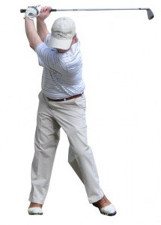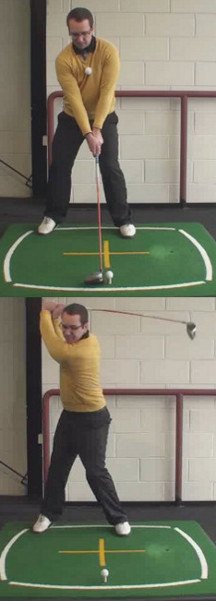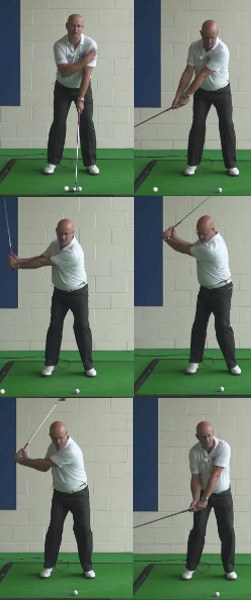
You'll often hear golf commentators or coaches describe how a player “sets the club at the top.” They're referring to the position of the club, arms and hands at the completion (top) of the backswing. Let's take a detailed look at this critical juncture of the golf swing.
Several elements determine how a golfer sets the club. There's the takeaway, the hinging of the wrists as the club is lifted higher, the shoulder turn, and the extension of the left arm (for a right-hander) away from the body.
There's no hard-and-fast rule as to how the club should be set at the top, but the classic position finds the club shaft parallel to the ground and the clubface square; viewed from the golfer's right and looking toward the target, a square clubface will appear perfectly aligned with the back of the left hand and forearm.
Some golfers, like the late Seve Ballesteros, set the club very early in the backswing, cocking their wrists quickly and maintaining the angle between the shaft and left arm all the way to the top. Most players, however, cock the wrists continually from the waist up and stop at the completion of the backswing.

Two keys to remember as you set the club:
- Don't allow the wrists to break down at the top. If the club dips well past parallel, you'll lose both control and power. Keep the wrists supple yet firm.
- The arms and shoulders should stop simultaneously. If your arms continue going back once the shoulders have stopped rotating, timing goes haywire and your weight shift is wrecked.
Keeping the shoulders, arms and wrists in sync when setting the club is critical to making an efficient, compact swing.

What Does It Mean to Set the Club at the Top?
Getting the club into a 'set' position at the top of your swing is one of the most important fundamentals you need to consider within your technique. But do you know what it means to set the club? Many golfers have heard this term without ever receiving a full explanation of why it is important – or even how to do it. In the content below, we will address the issue of what it means to set the club at the top of your backswing, and why it is so important to the success of your ball striking.
When you watch professional golfers competing in tournaments on television, you can be sure the each and every one of those players is setting the club nicely at the top. While they all have their own unique way of getting to a set position, they all get there before they get deep into the downswing. It is nearly impossible to generate power in your golf swing without getting the club set, so this is not an optional part of the swing for a high-level player. If you wish to take your game to the 'next level', working on your club set should be a focus during your practice sessions.
It is important to understand that setting the club is important in terms of the quality of your ball striking, not just your power. Most people think that they need to set the club in order to generate speed in the downswing – which is true – but you also need to work on your set to make sure you can strike the ball cleanly. It is tough to make good contact at impact if you never managed to get the club set up at the top. Once you manage to integrate a proper set into the top of your backswing, you should quickly notice an improvement in both power and clean ball striking – and those are two things that every golfer can appreciate.
In addition to having a positive effect on your full swing, setting the club correctly at the top of your swing can also help you hit better short game shots. Even when you are only pitching the ball 30 or 40 yards, a good set can help you clip the ball cleanly with plenty of backspin. The mechanics of getting the club set on your shorter shots are nearly identical to what they are in the full swing, so learning this technique is likely to help you all throughout the bag (except with the putter, of course).
All of the instruction contained below is based on a right handed golfer. If you happen to play left handed, please take a moment to reverse the directions as necessary.

Evaluating Your Set
Assuming you already play golf, you already have some form of swing that you are hoping to improve. Before you can work on improving your club set at the top of the backswing, you need to find out exactly how you are doing currently in terms of the set. After all, if you are already doing a good job of setting the club, you can cross this point off your list of golf swing techniques to learn.
Before we get into the process of checking on your set at the top, we need to make sure you have a clear understanding of what it means to set the club. Basically, setting the club involves hinging your wrists during the backswing to the point that the club and your left arm form at least a 90* angle at the top of the swing. Some players prefer to take care of the wrist hinge early on in the backswing, while others wait until the club is all way at the top to get the club set completed. There isn't necessarily a 'right' or 'wrong' way to do it – as long as you get it done, and you do it the same way over and over again. Countless amateur golfers fail to get the club set at all in the backswing, and the results of their shots speak for themselves. If you don't yet set the club actively in your backswing, you are going to be in for quite and adjustment during your upcoming practice sessions – but those adjustments will be worth it when you see just how drastically your ball striking can improve.
So, are you currently setting the club correctly, or does this part of your swing need some work? There is only one way to know for sure, and that is to take a look at the current state of your golf swing. The best way to do this is with the use of assistance from a friend and a video recording device. During an upcoming range session, ask a friend to record your swing on video so you can watch it back to evaluate your mechanics – specifically, your setting of the club.
To decide if you are setting the club properly, look for the following points on your video recording –
- Club perpendicular to left arm at the top. As mentioned above, you should be forming an angle of at least 90* between your left arm and the shaft of the club at the top of the swing. To evaluate this point, the best thing to do is simply pause the video when the club starts to change directions from backswing to forward swing. With the video paused in just the right spot, it will be easy to decide if you have achieved a full set in your swing. If you are barely getting to 90*, or if you are well short of that mark, you will have some work to do on your set.
- Position of your wrists. While watching your swing over and over again, monitor the movement of your wrists as you take the club from address up to the top of the swing. Ideally, you will see that your wrists are quiet within the first foot or so of the swing, as you move the club head gradually away from the ball. Then, as the club head starts to lift off of the ground, your wrists will begin to get involved with the swing. If you don't see that pattern in place in your swing – either your wrists are active right from the start, or they aren't active at all – you will know there is a problem.
- Shoulders at the top. The wrists are the main determining factor in the success of your club set, but your shoulders play a roll as well. Basically, if your shoulders have barely turned away from the target at the top of the swing, you will know that you are only swinging the club by using a wrist set – and that is bad news for the rest of your swing. The setting of the club with your wrists is important, but it does not take the place of a full shoulder turn on the way back. When you pause the video of your swing at the top, you should not only see a great set between your wrists and the shaft of the club, but you should also see that your back is turned to the target. If you can confirm that both of those pieces are in place, you will be on your way to great ball striking.
If you are happy with what you see on the video, you can move on with confidence to work on other parts of your game. After all, there is no sense in trying to fix something that isn't broken in the first place. Of course, if you are like the majority of other amateur golfers out there, you will probably be less-than-thrilled with the status of your club set at the top of the swing. In that case, please feel free to read on for some instruction on how you can improve that set.

The All-Important Takeaway
It might seem a little counterintuitive, but one of the most important parts of the club set is actually the first foot or so of the swing – where you aren't setting the club at all. The takeaway should be a 'quiet' phase of the swing, meaning that nothing much is happening except for a turning of the shoulders away from the target. Many amateurs get this part of the swing completely wrong, and they struggle to get back on track later on. Work on taking all unnecessary movement out of your takeaway and your swing as a whole will be better for the effort.
The problem with hinging your wrists during the takeaway is that your arms are not yet in a position that will lead to a proper set. Hinging the wrists almost immediately after the club starts in motion – which is what many amateur players do in their swings – will usually force the club head well to the inside of the proper swing path. From there, you will stay inside the rest of the way up, and you will likely be well 'across the line' at the top. While the club will technically be set in that your wrists will be hinged, it will be out of position and you will usually hit the ball well off line. If you struggle with the slice like so many other golfers around the world, there is a good chance that an early wrist hinge is the culprit.
While it might seem too simple to be effective, all you need to do during the takeaway is turn your shoulders away from the target while keeping everything else as stable and steady as possible. Your posture should remain stable, your hands should be quiet, and your eyes should stay on the ball. In other words, a good takeaway is a boring takeaway. The exciting parts of the swing will happen later – for now, you just want to move the club back without causing any problems that will lead to trouble later on.
To practice making a quiet and controlled takeaway, consider using the simple drill outlined below.
- While at the driving range (or even in your backyard, if you have room to swing safely), set a golf ball down on the ground and take one of your mid-irons from the bag. Take your stance over the ball as you would for any other shot, and be sure to get into a good posture.
- Once you are set, you are going to make one key adjustment before starting your swing – you are going to place the club head down on the ground in front of the ball, instead of behind it. Other than this one change, you are going to be using your normal stance.
- With the ball behind your club head, start your takeaway, pushing the ball back to the right as you go. Focus on turning away from the target with your shoulders while keeping your hands as quiet as possible.
- Continued the takeaway until the ball rolls away from the club. You can either continue on with the rest of the swing from this point, or you can stop and repeat the takeaway portion over and over. Either way, you shouldn't actually be hitting the ball with this drill – the ball should roll away to your right and you can go retrieve it when you are done to start over again.
If your hands are staying quiet, this drill should be extremely easy to complete successfully. The ball will roll nicely off of the club head, and it will follow a line that roughly matches up with the imaginary target line for this swing. However, if you use your wrists too actively in the takeaway, there are going to be problems right away. The active wrists will either cause the ball to be pulled well to the inside as it rolls back, or they will cause the club head to lift up off the ground and over top of the ball – each of these outcomes would be a sign that something is wrong. Work with this drill from time to time until you can consistently roll the ball straight back away from the target, a sure sign that your hands are nice and quiet within the takeaway phase of the swing.

Early or Late Set?
Now that you have tested your set and you understand how to keep your takeaway as quiet as possible, you will need to decide if you are going to use an early or late set in your swing. As was mentioned above, there is no right or wrong in this case – both options can be used to hit excellent golf shots. This choice is a personal one, so don't make it based on the swing of someone else that you are trying to copy. Experiment with both options and stick with the one that feels right and gives you the best results.
Following is a quick guideline to which type of golfer is likely to prefer which style of setting the club. These points should not be considered 'rules' so much as suggestions – in the end, it will be up to you to decide which way is going to serve you best.
- Early set. The early set is usually used by players who want to make a quick golf swing with a quick tempo. By engaging your wrists early in the swing (but still after the takeaway), you will pick up the pace early on, and that pace will usually be carried on to the end of the swing. The club head gains speed naturally when you set your wrists, so doing so before you even get halfway back is going to set you on a path for a quick swing. Of course, there is nothing wrong with a quick swing, but you need to be comfortable with that kind of tempo. If you are trying to make a slower, smoother swing, the early set could get in your way.
- Late set. As you would guess, a late set is usually preferred by players who want to use a slower overall tempo. If you want to let your swing build naturally without any sense of rush or urgency, you should wait to set the club until you are near the top of your swing. By keeping your hands quiet, your swing will only move along at the speed of your shoulder turn – which is almost always going to be slower than your wrist set. Once your shoulders are turned almost completely away from the target, you can then engage your wrists and prepare for the downswing. Players who use a late set are often some of the longest hitters, as they will generally be able to hold on to the lag longer into the downswing. However, there are plenty of long hitters who use an earlier set, so don't opt for the late option based on power potential alone.
The only way to be confident that you are making the right choice on this point is to try out both options for yourself on the range. Hit some shots while making an effort to set the club early on in the backswing, and follow that up with some shots where you set the club as late as possible at the top. You should judge the results not only on the ball flights that you create, but also on the way the swing feels. Which option gives you the most confidence? While do you feel like you could execute consistently on the course when the pressure is on? After hitting plenty of practice balls on the range, your decision on this point will likely become clear.

Moving On
Setting the club correctly at the top of the swing is important – there is no doubt about that point. However, what comes next is even more important in terms of the quality of shots that you are able to hit. Setting the club properly isn't going to do you any good if your downswing technique ruins everything that you have done correctly in the first half of the swing.
The key point to monitor in the downswing is your ability to maintain the angle that was set at the top. It is important to create a great angle between your left arm and the club shaft because you want to use that angle to your advantage late in the downswing. However, if you 'waste' that angle by unhinging your wrists almost as soon as you start the downswing, your ball striking will never live up to its potential. It is crucial that you hold that angle for as long as possible coming down, only letting it go when it is absolutely necessary in order to strike the ball.
You may already know that most amateur golfers lose their angle as soon as they start the downswing – if they even set the angle in the first place. If there is a single reason why amateur players are not able to hit the ball as far as their professional counterparts, this is it. By giving up the wrist set that was created in the backswing, potential club head speed will be lost forever and the player will be left to drag the club through the hitting area. If you struggle to hit your shots what you would consider to be an acceptable distance, there is a good chance you are throwing away your angle before you get the chance to use it.
Working on your ability to set the club can do wonders for your golf game. By getting the club set correctly at the top, you will be setting yourself up for a powerful downswing that unloads plenty of speed into the back of the ball. Of course, you still need to do many other things correctly in order to consistently hit good shots, so you shouldn't expect this one piece of your technique to solve all of your problems. Once you are satisfied with your set, move on to working on other parts of the swing until everything comes together into a cohesive move which produces great results.






